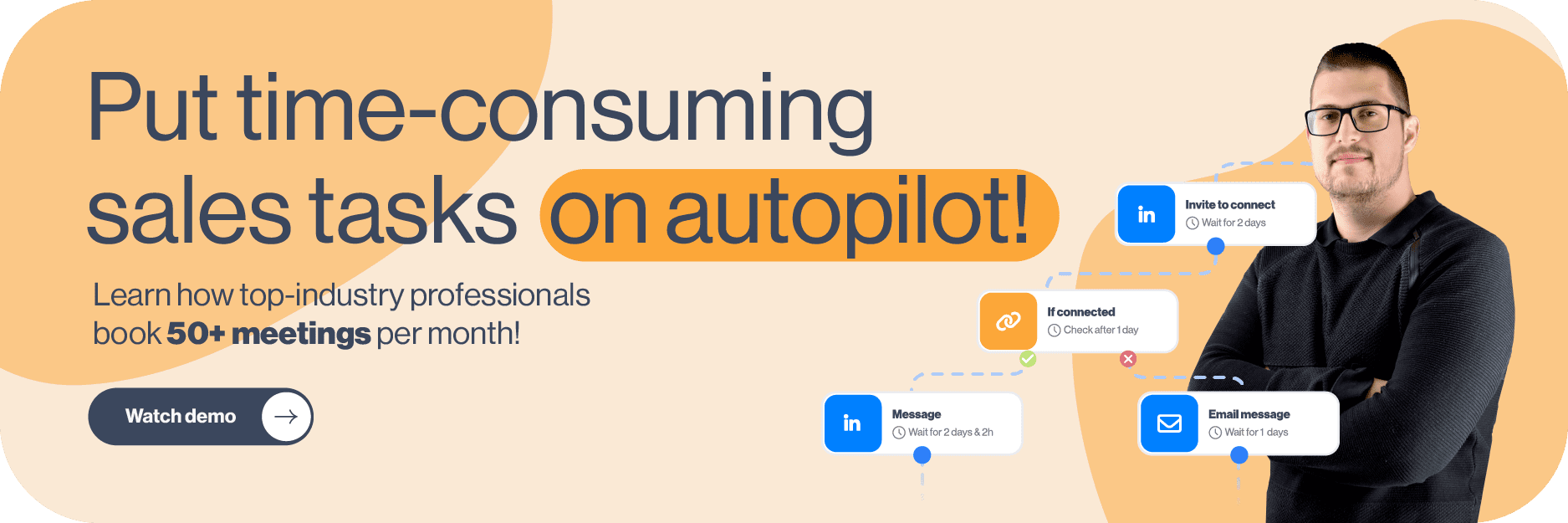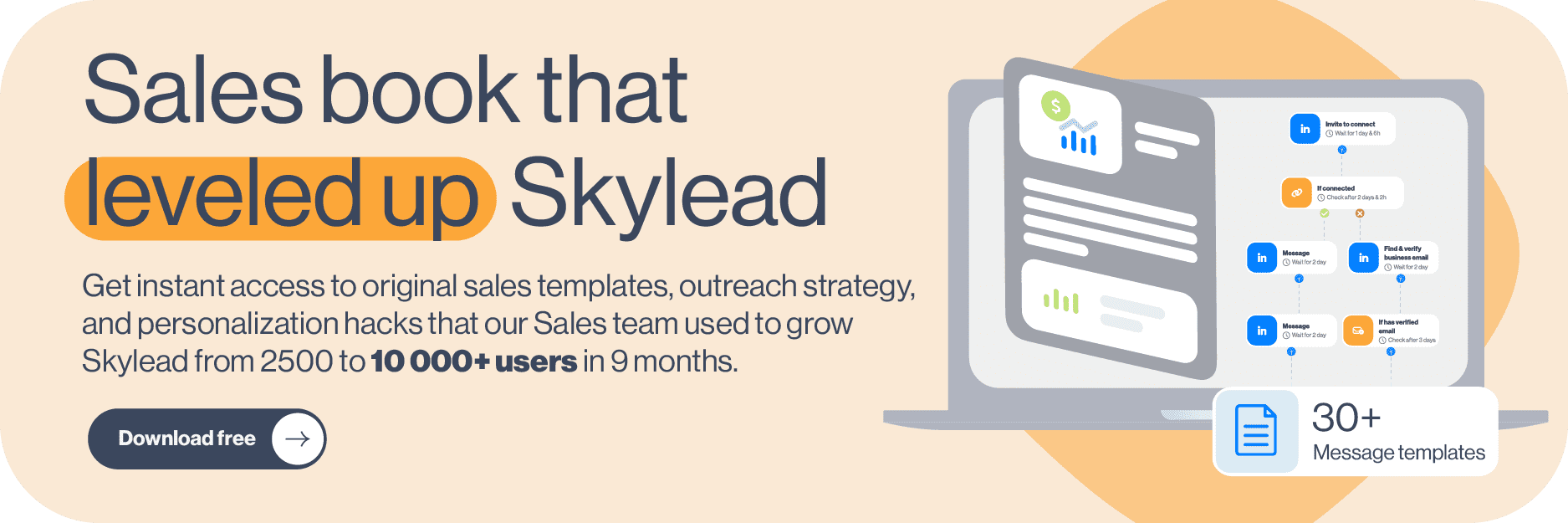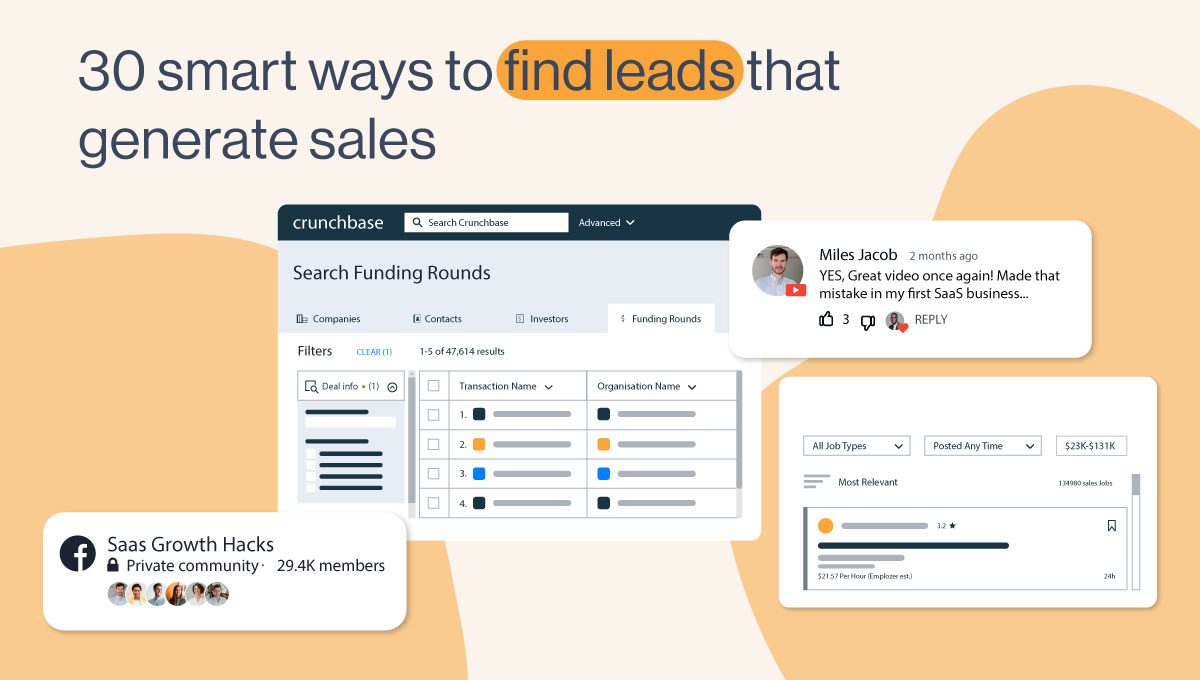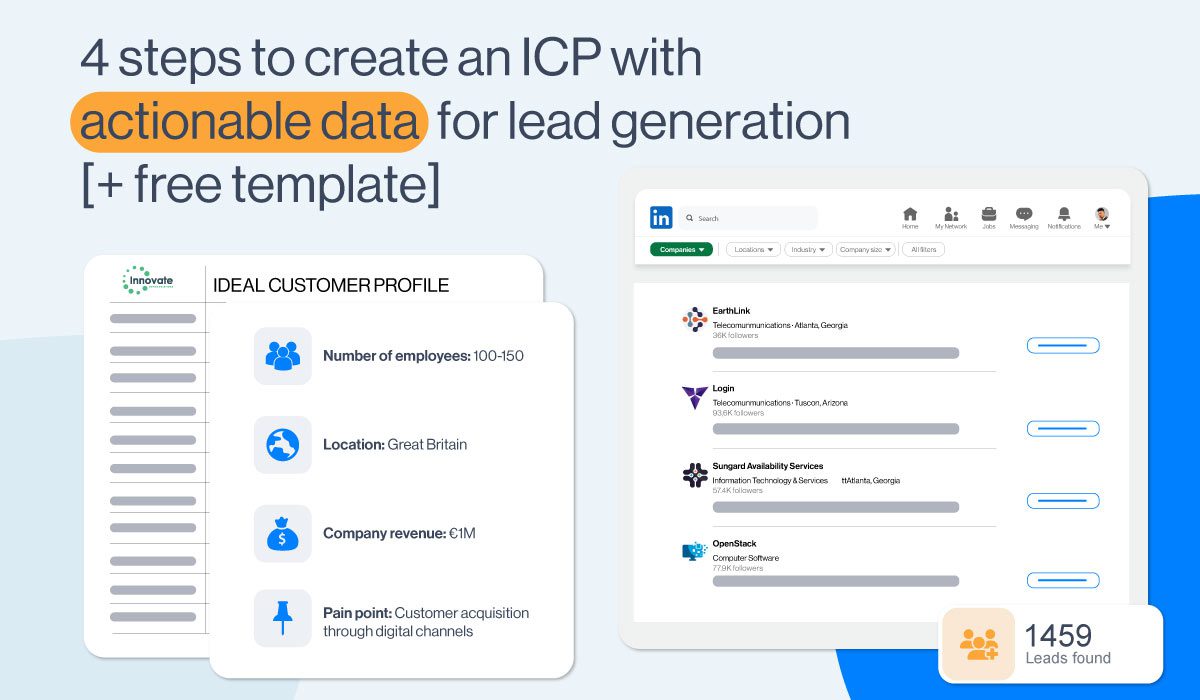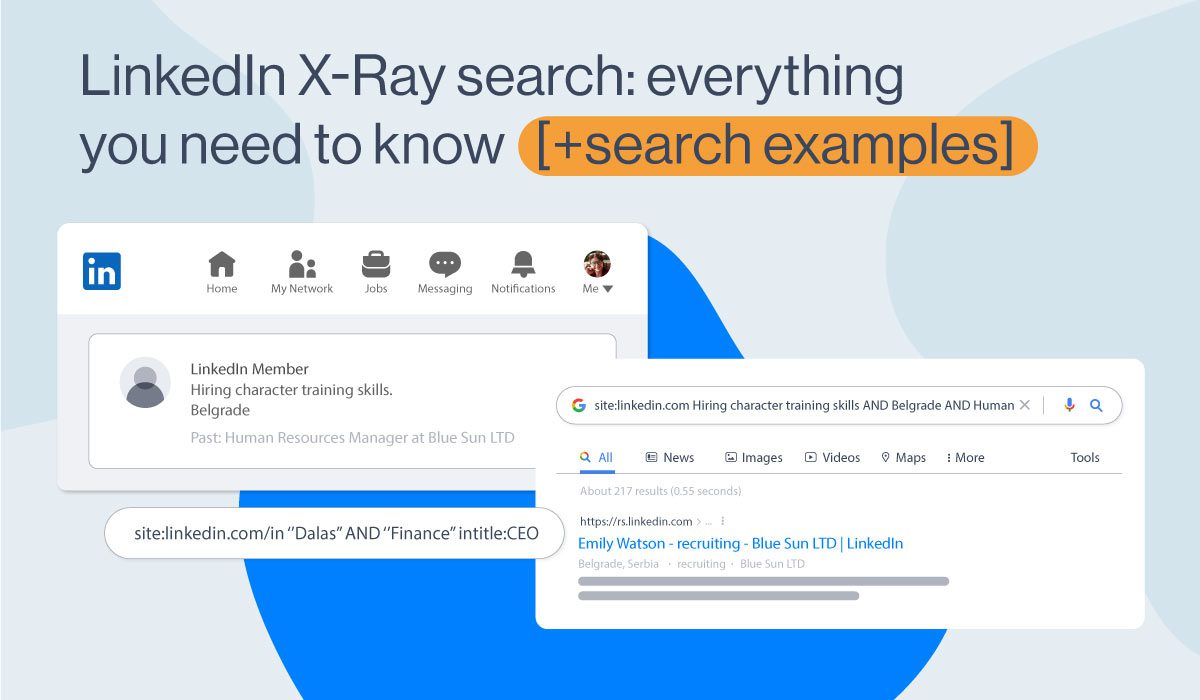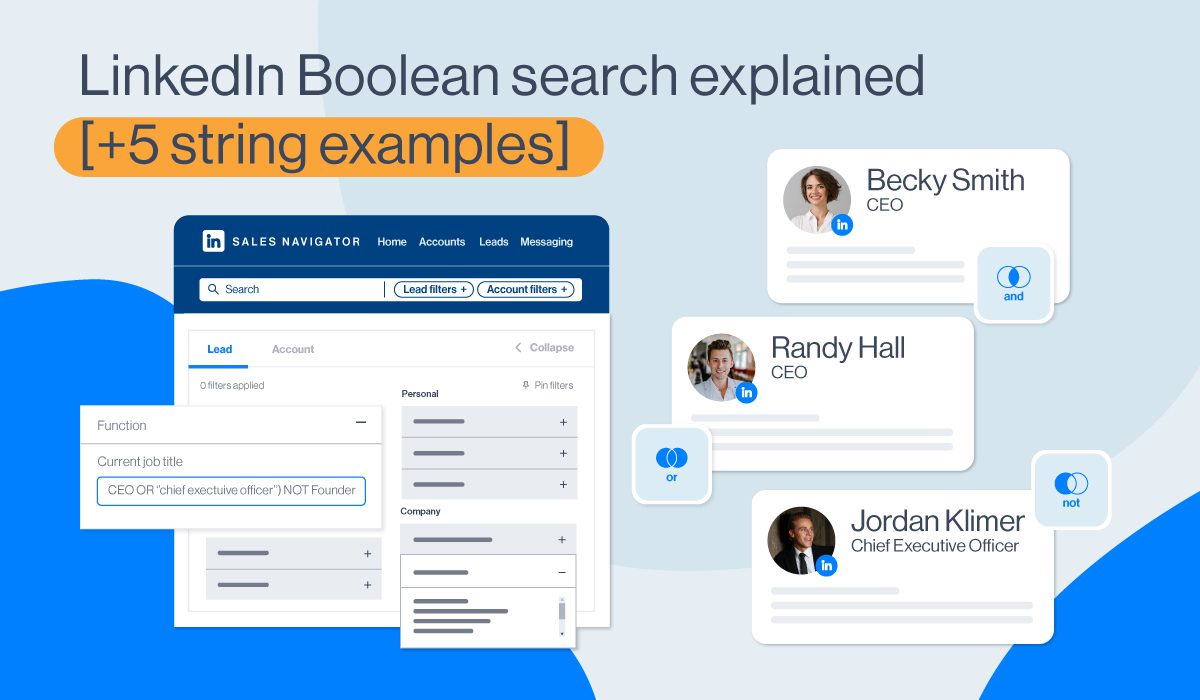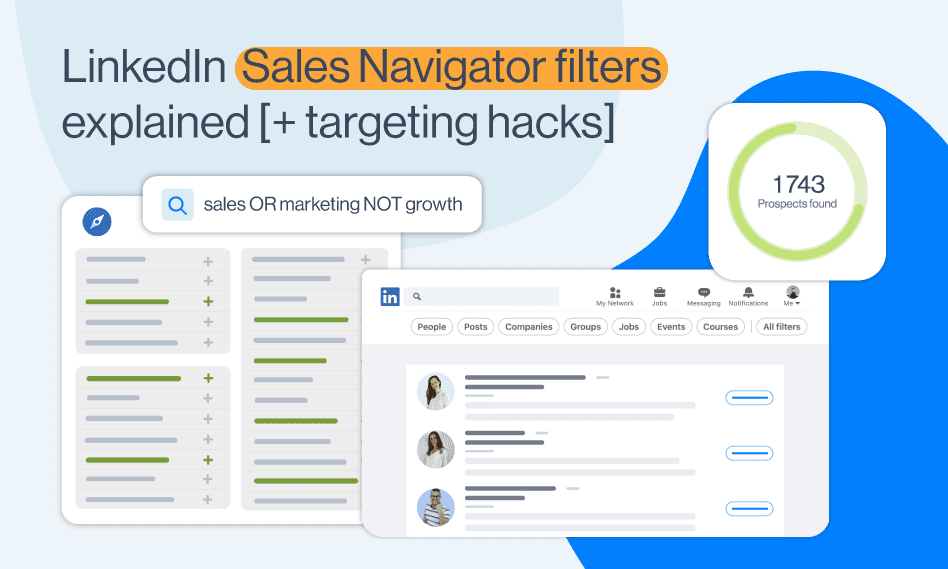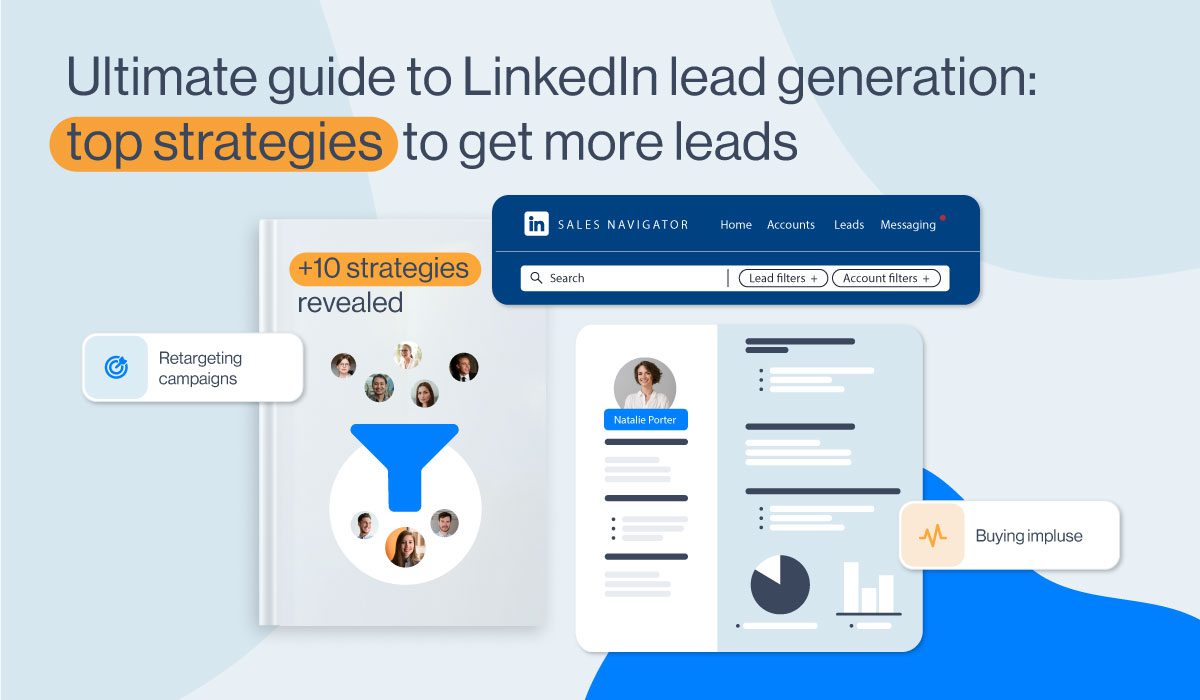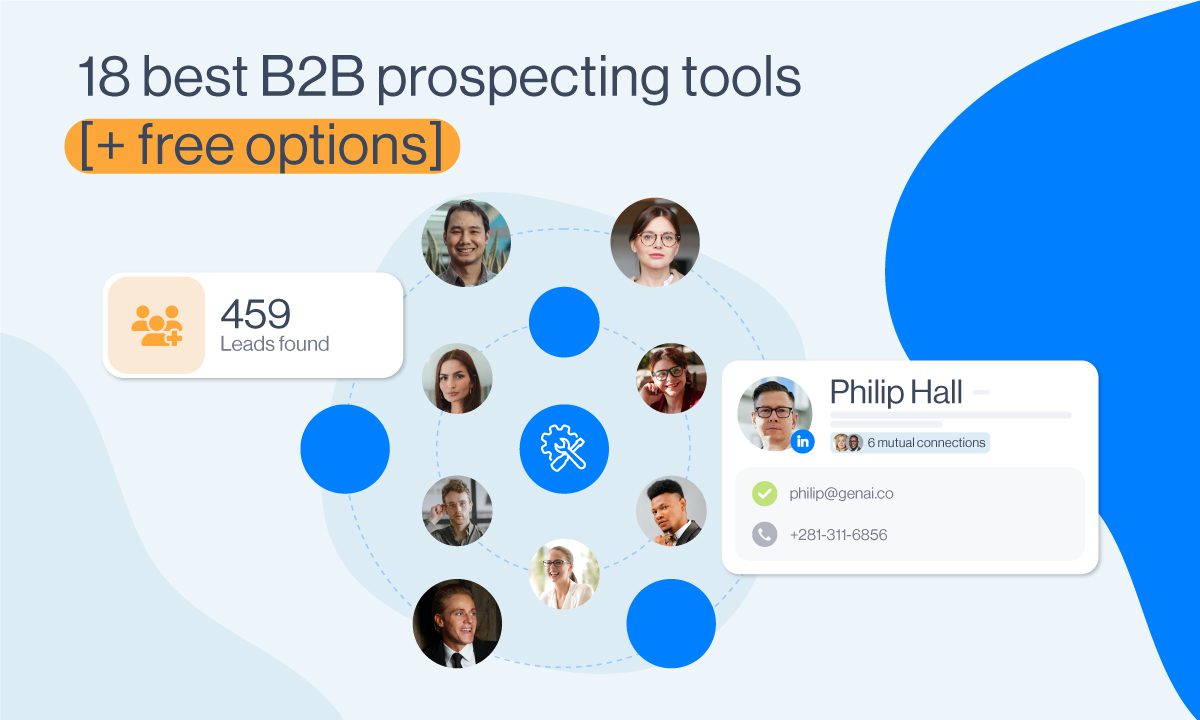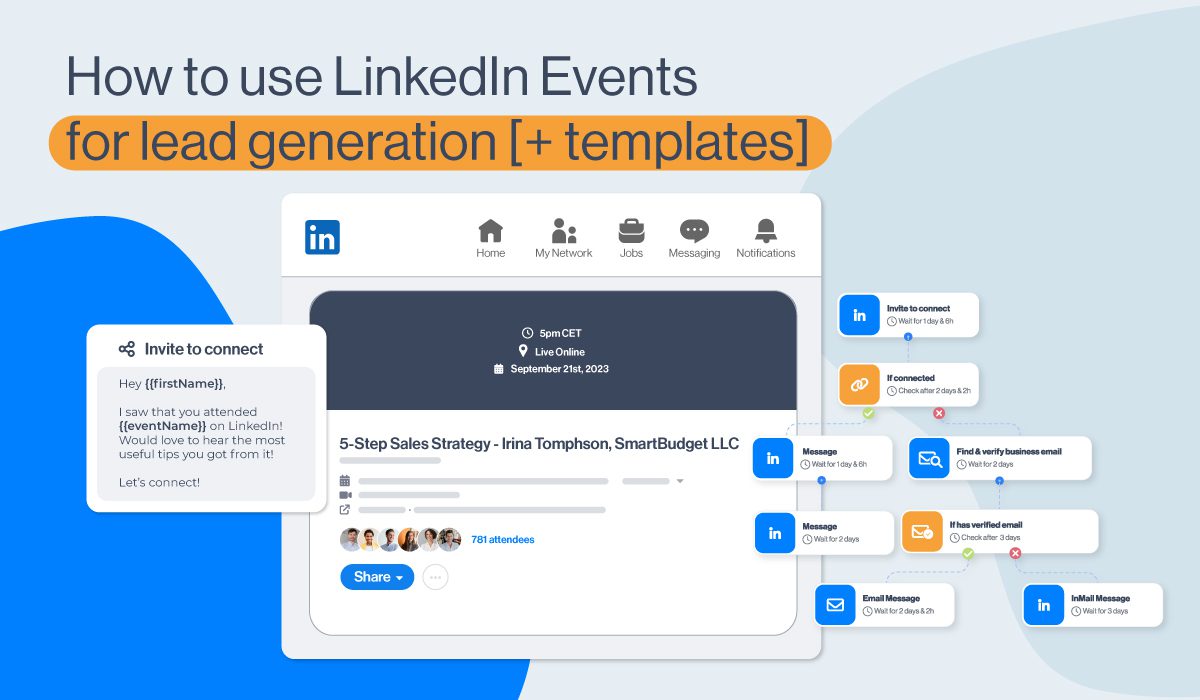LinkedIn prospecting: 18 strategies and 3 tools for 2024
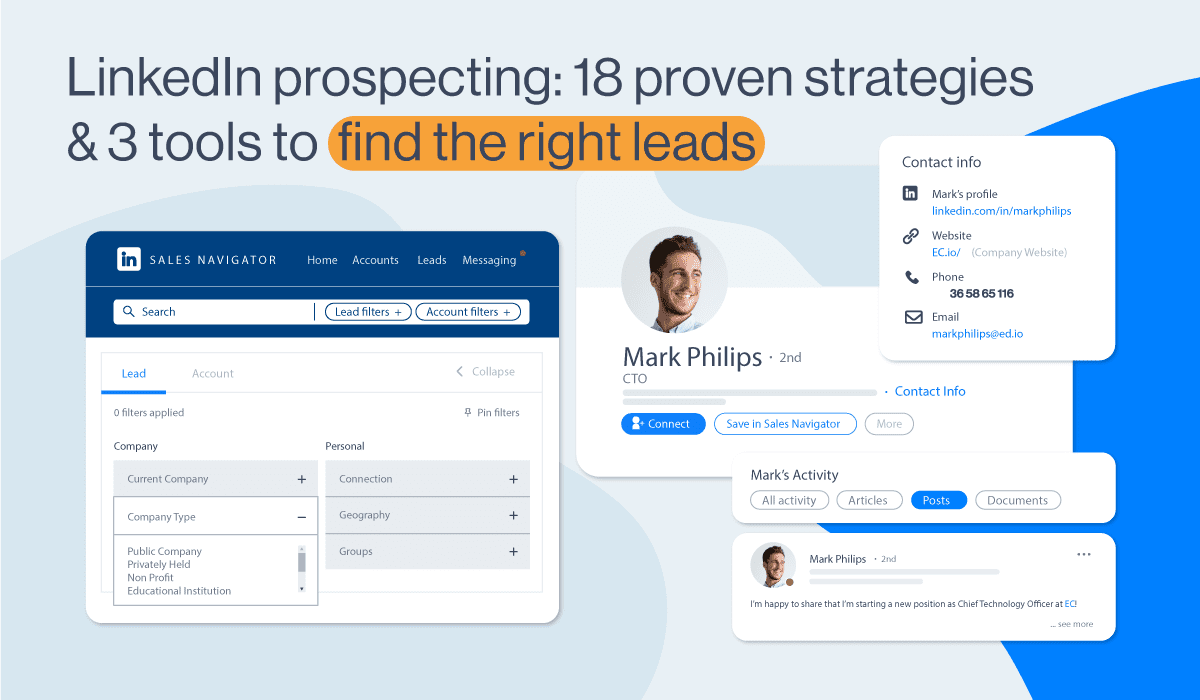
Looking for leads? Ever heard of LinkedIn prospecting? It’s about time you do!
If we know that LinkedIn is the largest professional social media network in the world, with a staggering 1 billion users, of whom 65 million are decision-makers, then it’s safe to say that it is a place to be for prospecting. Our complete guide on LinkedIn prospecting will cover:
- the concept of LinkedIn prospecting
- why LinkedIn is the best place for prospecting
- how to get started
- the do’s and don’ts of prospecting on LinkedIn
- 18 best strategies
- 3 tools that can help with prospecting
What is LinkedIn prospecting?
By definition, LinkedIn Prospecting is the practice where salespeople and recruiters leverage LinkedIn as a part of their social selling activity to identify and engage with potential customers among platform members. Their goal is to build professional relationships and offer products or services that best meet their needs.
What does LinkedIn prospecting mean?
LinkedIn is a professional network ideal for B2B (business-to-business) interactions, where salespeople can find and nurture potential business clients. It’s all about identifying the right target audience and fostering relationships with them, using the platform's features to manage the entire process.
But how does it work? LinkedIn helps you spot new prospects by providing insights into members' job titles, company information, and some personal information—key data for your outreach. Look at your prospect's LinkedIn profile as a gold mine of information, crucial for deciding if they're a fit for your product so you can plan and personalize messages and follow-ups.
Before reaching out, we believe that studying your prospect's profile is essential. Connecting is only the start; understanding how your product can help them and genuinely caring about their business is what can keep the conversation going. This process is gradual and involves patience, thoroughness, and constant optimization.
Now that you’ve found and studied your target audience, we get to initial contact. Cold outreach on LinkedIn involves contacting potential clients you haven't met before, aiming to pitch your product or service. But it's not just about the pitch; it's about building relationships and understanding their needs.
Remember: LinkedIn prospecting isn't a one-size-fits-all formula. It's complex, demands a solid strategy, and depends on many factors. But there's a reason LinkedIn is a top pick for social selling and online prospecting, as you’ll come to learn while you go through this blog.
Why LinkedIn prospecting?
LinkedIn differs from other social media platforms like Instagram, Facebook, and Twitter because it's focused on B2B relationships. It's a one-stop shop for finding business contacts. Plus, it supports both prospecting and lead generation.
We need to clarify something: Prospecting and lead generation are not the same. Prospecting is about identifying and nurturing potential customers, while lead generation attracts and converts customer interest. A prospect is a qualified contact, whereas a lead is unqualified.
In recent years, the pandemic shifted these activities to the online world. This was when social selling became a thing - the practice of using social media to find and build relationships with prospects to meet sales goals. LinkedIn, being a professional, B2B-focused platform, has thus gained more advantages for social selling, as it supports all stages of the sales process.
However, success on LinkedIn isn't easy. Sales teams face the challenge of identifying the right business contacts among many, and decision-makers on LinkedIn are flooded with LinkedIn connection requests, regular messages, and InMails. But don’t worry! There are strategies to stand out and connect effectively with potential clients, which we will cover later in this blog.
How to get started with LinkedIn prospecting?
1. Define your Ideal Customer Profile & Buyer Persona
An ideal customer is someone who will benefit from the product or service on many levels and has also shown interest in it. In marketing and sales, we call that a qualified prospect.
Defining your ideal prospects helps focus your sales and marketing on the most promising leads. In B2B, this means understanding the Ideal Customer Profile (ICP) for target companies and the Buyer Persona for their decision-makers or a person who will use your product.
Knowing these details improves how you identify and approach them on LinkedIn, making your social selling more effective while saving time in future outreach efforts. In fact, our Head of Sales, Andrea, says that if you define your ICP and Buyer Persona right away and you do it correctly, you won’t waste time on bad results.
Let’s go over them. 👇
Ideal Customer Profile (ICP) describes companies that benefit most from your product or service. These companies typically have:
- the fastest conversion cycles
- highest customer retention
- highest lifetime value (LTV)
- are likely to refer your product or service to others.
Buyer Persona is a detailed profile of your ideal customer, encompassing behavioral, demographic, firmographic, and psychographic traits. This persona represents someone who:
- Experiences pain points directly addressed by your product or service,
- Is a decision-maker,
- Contributes to a shorter buying cycle when aligned with the ICP,
- Actively advocates for your product.
Note: Each company that fits your ICP can have one or more than one Buyer Persona for you to target. In short, ICP represents the company profile, while the Buyer Persona focuses on the particular type of person’s profile within that company.
2. Find potential customers
Once you’ve defined your Ideal Customer Profile and Buyer Persona, it’s time to find them on LinkedIn. You can use LinkedIn to understand their pain points and keep all communication in one convenient place, from initial contact to follow-ups.
But that’s not all LinkedIn does. It encourages a series of behaviors through certain features that we can use to find ideal prospects and build B2B relationships.
- LinkedIn allows networking among the members attending the same LinkedIn event despite some members not being connected.
- LinkedIn awards posting relevant content by giving these members greater exposure on the platform.
- LinkedIn gives you options to join LinkedIn groups of your interest. Use Sales Navigator to target members of a LinkedIn group.
- Reach busy decision-makers through paid and free LinkedIn InMails
- You can use numerous filters to find your ideal prospects.
You will find strategies on how to effectively find more prospects later in the blog.
3. Structure your campaign
Effective LinkedIn connections go beyond just sending requests to users matching your Buyer Persona. It involves a detailed outreach plan, including:
- a LinkedIn strategy
- message flow
- messaging frequency
- follow-up actions
- identifying the prospect's preferred communication method (LinkedIn, InMail, email, or call)
- strategically timing your sales pitch
- optimizing your outreach for better results.
We know, it’s a lot to keep track of: conversations, relationship stages, and buyer's journey positions for multiple prospects. This is why we recommend you use a CRM (Customer Relationship Management) software for your LinkedIn leads. It organizes customer data and streamlines lifecycle processes, replacing countless spreadsheets and documents.
4. Reach out & follow up
Once your LinkedIn outreach campaign is structured, start connecting with potential customers. Remember, first impressions matter in social selling. Look at it like this: your profile is your business card; members will take a peek and focus on your profile picture, cover photo, LinkedIn headline, and LinkedIn summary.
An all-star-status profile increases views and connections due to higher search visibility. When reaching out, ensure every message, whether a connection request or InMail, is personalized, showing you've researched the recipient and leaving room for conversation.
Follow-ups are key in outreach. Not all potential customers will be immediately responsive, especially busy decision-makers with a ton of requests. Be persistent but also recognize when to pause with outreach and wait for a better opportunity to re-engage. Also, be sure to try templates.
5. Automate your LinkedIn outreach
We’ve come to our favorite part: outreach automation. ✨
LinkedIn automation tools can be the secret ingredient to your business success. With these powerful tools, you can streamline almost all outreach tasks, such as:
- Sending messages (regular messages, InMails, emails)
- Follow-ups
- Profile views
- Scrape data
- Personalize data (Image & GIF personalization, videos)
- A/B test content and more.
Automation tools save time, allowing more focus on crafting sales messages and closing deals. When it comes to the type of automation, cloud-based automation is the way to go. They are safer and can operate independently of your computer, unlike Chrome extensions or desktop apps, which can lead to account bans and you ending up in LinkedIn jail.
The good news is that advanced tools like Skylead use smart algorithms for efficient prospecting and add cold email outreach to the LinkedIn outreach equation. By offering multichannel outreach, a Smart sequence builder, hyper-personalization, and an email discovery & verification feature, Skylead gives its users safety, efficiency, and the ultimate outreach experience.
6. Combine cold emailing with your LinkedIn outreach
A cold email is an unsolicited email that is sent to your prospect without prior contact as part of your cold outreach strategy. It could also be defined as the written equivalent of cold calling. Cold email outreach, just like LinkedIn outreach, aims to make contact with prospects and build professional relationships for the sake of sales as an end goal.
Since sales processes moved mostly online, the combination of LinkedIn outreach and cold emailing has given the best results. From our experience, we believe that combining LinkedIn with cold email outreach will increase your chances of getting to your desired prospects and converting them. Pavle, our sales executive, used a multichannel sequence to reach a 35% reply rate.
The 18 most effective LinkedIn prospecting strategies
As promised, we’ve done the research so you don’t have to, and now we present the 18 most effective LinkedIn prospecting strategies that are likely to bring qualified prospects for your business. Let’s review the list.
1. Use the Boolean search to narrow down your prospects
LinkedIn Boolean search allows you to combine words and phrases using the Boolean operators AND, OR, and NOT to limit, broaden, or define your lead generation target. Both LinkedIn and Sales Navigator filters support this type of search.
Keep in mind that the Boolean search can help you focus your prospecting efforts on ideal potential customers of a niche market that works best for your business.
2. Target LinkedIn event attendees
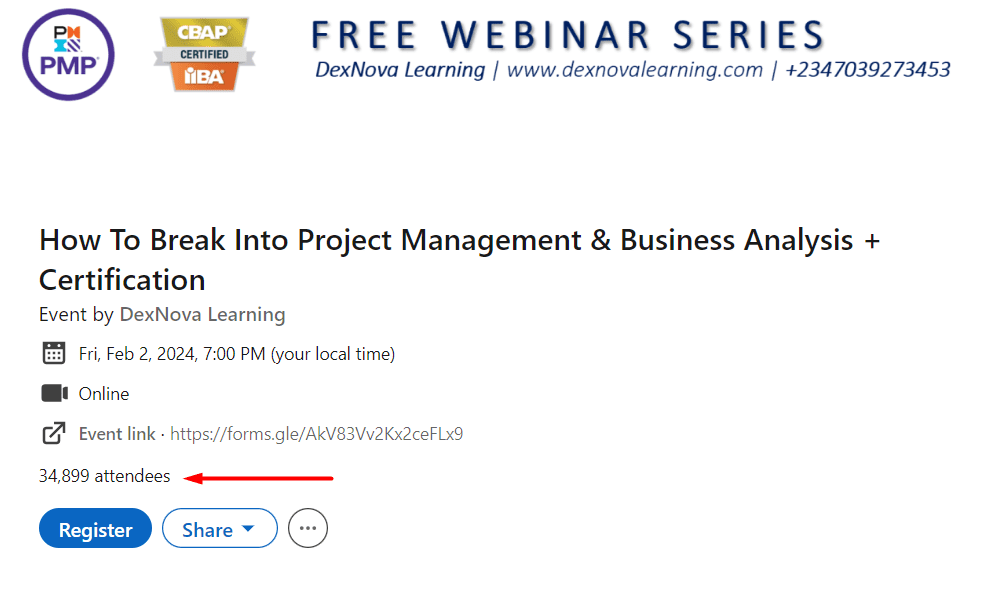
LinkedIn event attendees might not all be connected, but what connects them is what your sales pitch might be. To target prospects at LinkedIn events, focus on events your ideal audience attends. This approach not only groups them in one place but also offers insights into their needs and perspectives, which you can use to get to know them better and connect.
3. Use LinkedIn groups for prospecting
Yes, we know. Most of the LinkedIn groups are dead. However, their members are still there, despite being inactive, gathered around a common interest. This is why targeting LinkedIn groups for LinkedIn prospecting is recommended.
However, if some of these communities are active, make sure you take time and genuinely engage with them. Ask questions, offer advice, share your experience, and answer and comment on posts. Aside from high-quality prospects, you might gain valuable insights into your Buyer Persona’s problems and needs.
Remember: LinkedIn allows you to send a direct LinkedIn message to each group member without being connected to them. This is how you find groups of your interest. 👇
Option 1 - LinkedIn basic and Premium users
#1 Run a blank search or enter a keyword in the LinkedIn search engine. Use other available filters if needed.

#2 Choose your ideal LinkedIn group and click “Request to Join.”
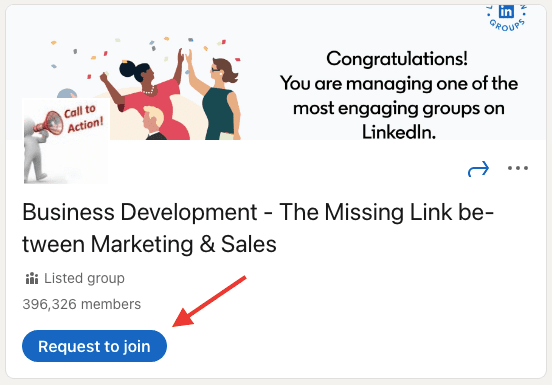
#3 Once you get accepted, this is where you find the list of members - or your prospect list. 😉

Option 2 - Sales Navigator filters: Group filter
You can find members of different LinkedIn groups through Sales Navigator filters. Unlike other LinkedIn users, you can narrow down LinkedIn group members further to fit your search criteria even better by applying other filters.
#1 Open Lead Filters
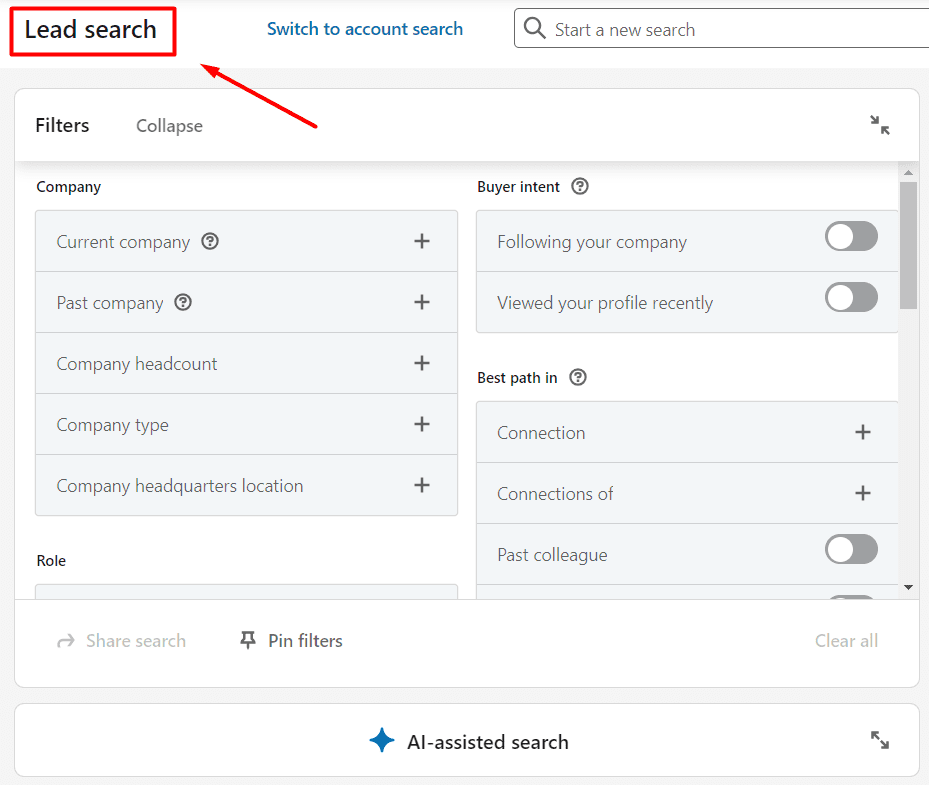
#2 Scroll down to the “Groups” filter. Put in a keyword or the exact name of the LinkedIn group.
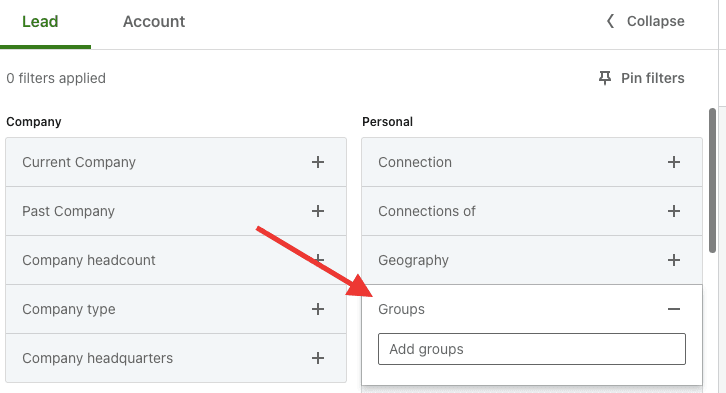
#3 Sales Navigator will suggest other similar groups.
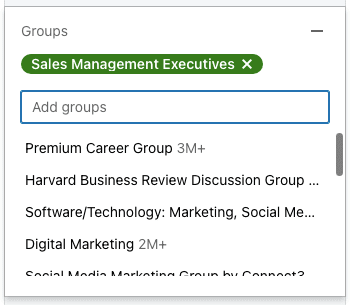
Note: Once you’ve chosen LinkedIn groups of interest, use other Sales Navigator filters to narrow your search results.
4. Take full advantage of free & paid InMails
LinkedIn InMail message is a direct private message to or from a LinkedIn member who is not part of your network. LinkedIn members that are not part of your network can be your 2nd or 3rd-degree connections.
If you’re not yet connected with your prospect, you can still send them messages, and this is where InMails comes in. Make sure to combine both free and paid InMails for a more effective outreach. However, our experience has shown that it is more effective to use InMails as the last step of the sequence in outreach if LinkedIn and email combined do not give results.
5. The People Also Viewed feature
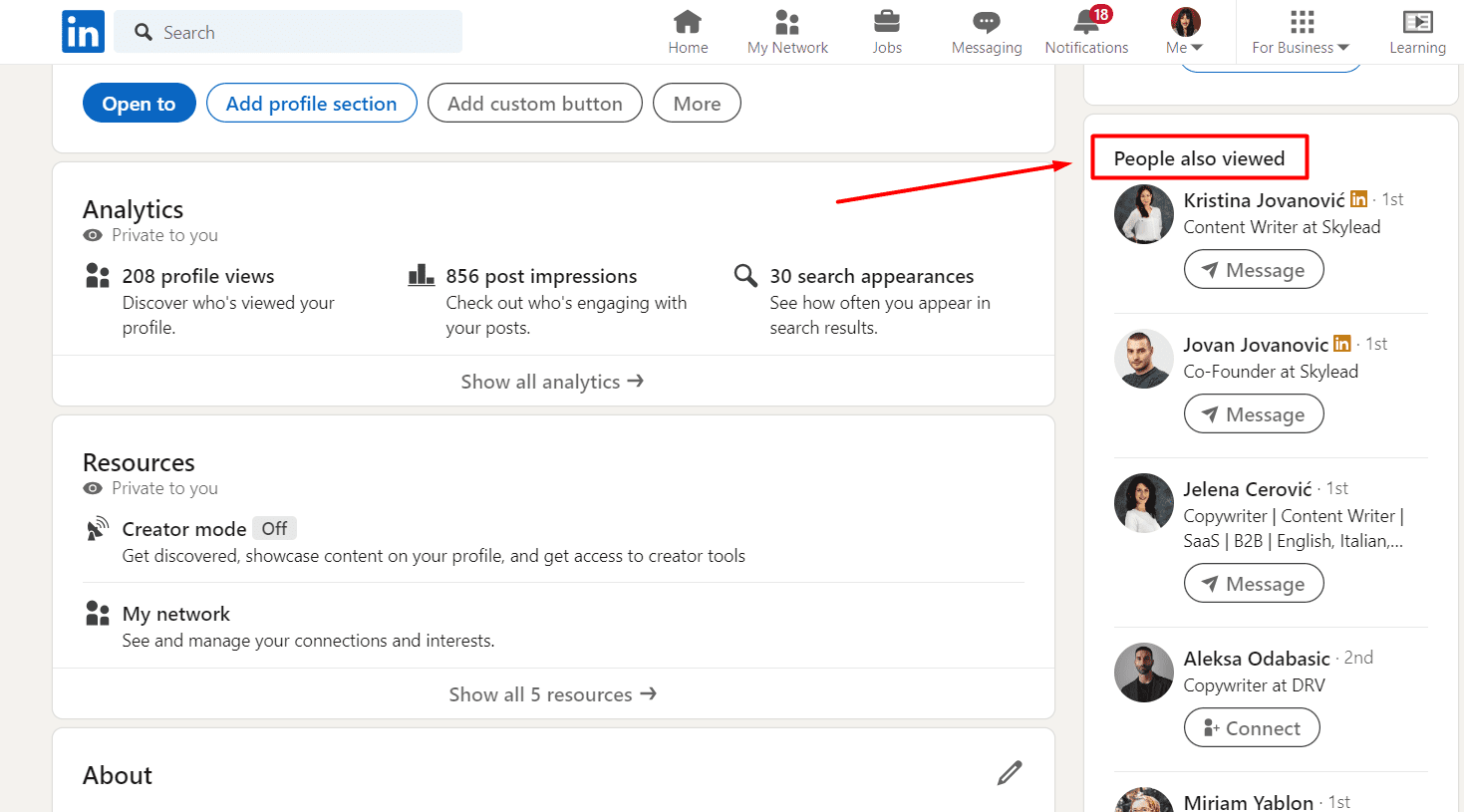
As you may know, the LinkedIn People Also Viewed feature displays a list of LinkedIn members that the platform’s algorithm found important for your LinkedIn experience, whether you are using the platform for networking, job search, or lead generation. Use the algorithm to your advantage and better target your audience.
6. The People You May Know feature
Unlike the People Also Viewed feature, People You May Know suggests LinkedIn members for you to connect with based on commonalities between you and those LinkedIn members.
LinkedIn recommends members who may have shared connections have similar profile information (experiences, company name, company size, industry, or attended the same school). You will see these profiles on the right rail of your LinkedIn profile.
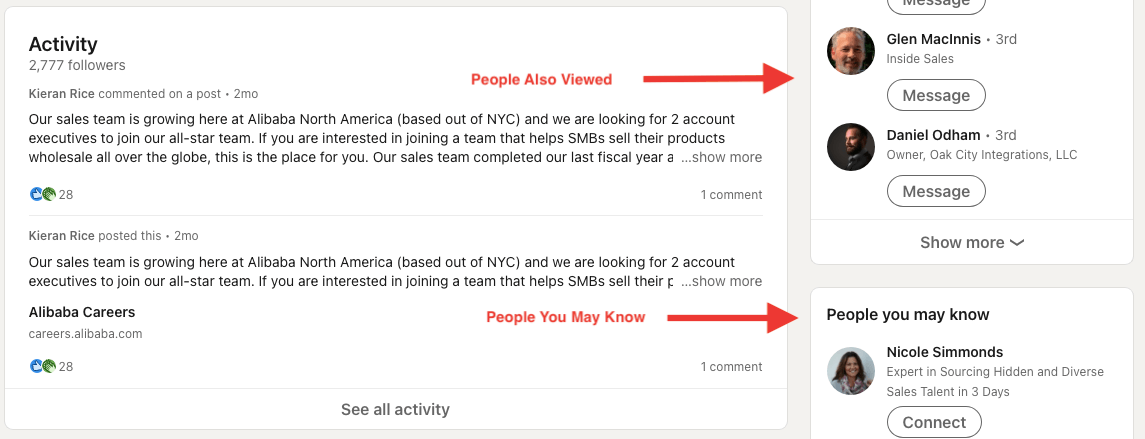
Leveraging mutual connections on LinkedIn is a strategic way to grow your network and connect with potential prospects. Mentioning a common connection can go a long way. It boosts acceptance rates, overall trust and helps build new professional relationships.
Note: Keep in mind that the better your LinkedIn profile is optimized, the more accurately algorithms will suggest members that fit your prospecting preferences.
7. Check your prospects’ Contact Info
We’ve already said that your prospects’ profile acts as a business card. Contact info sections usually contain everything you need to know to reach out. It’s available only for your 1st-degree connections.
“Contact info” can contain your prospects’ business email, private email, phone number, company website, and LinkedIn profile URL. However, not all of this information has to be filled out.
Here’s an example 👇
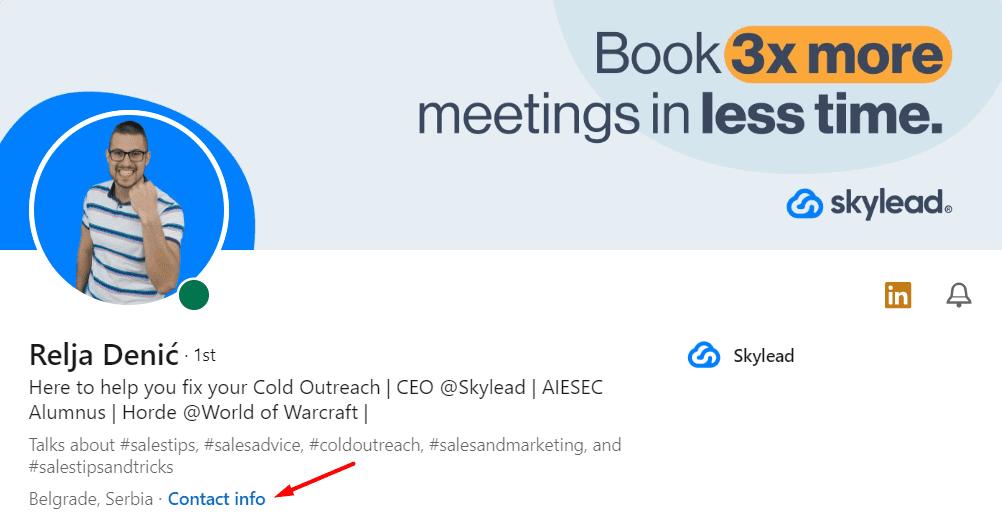
In this case, we see our lead’s business email, company website, and even phone number.
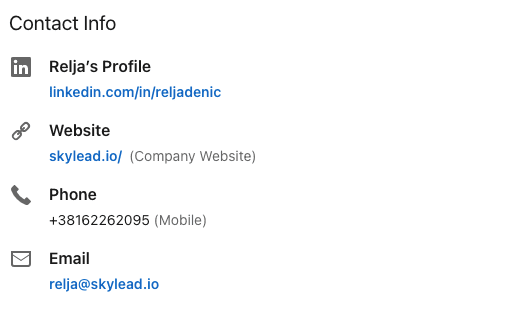
Some LinkedIn automation tools, such as Skylead, collect this publicly available information for you. All you need to do is move the toggle button to the right before creating your sequence. Skylead will collect all of your prospects' publicly available data and allow you to use it at any moment.
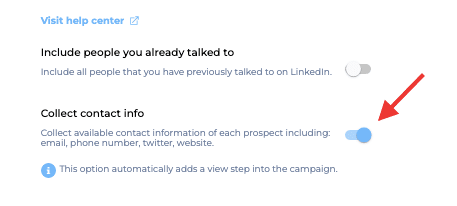
8. Follow job changes on your feed
If your 1st-degree connection changes jobs, you will get a notification. 🔔

It will show up in your feed as well. If your 2nd-degree connection changes jobs and the mutual connection reacts to it or posts a comment, you will also see it in your LinkedIn feed.
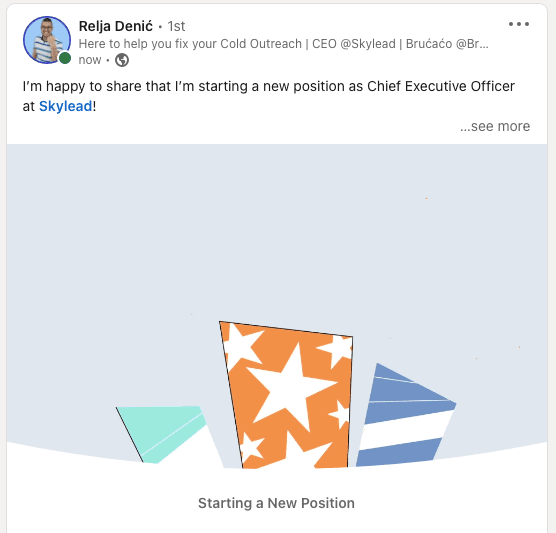
Regular updates on job changes are crucial for the LinkedIn prospecting process because a member's new job title may align with your ideal prospect profile. Additionally, leads in new decision-making roles are often more receptive to sales pitches, so you can use this moment to introduce your product/service to them.
9. The new job position alert
Setting job alerts for specific positions in companies is a long-term LinkedIn prospecting strategy. You'll get notifications about new openings, indicating company growth, investment in departments, or increased demand for their products or services. You can use these signals as an intro for your outreach efforts.
Seems convenient? This is how you set the New Job Position alert on LinkedIn 👇
#1 Write the job position or a keyword you wish to get altered for in the search bar. Then, click “Jobs.” Let’s say you are interested in the “Sales Manager” position opening.

#2 Set up the location (mandatory) first. Then, use any other filter under the “All Filters” option that will get you as close to your ICP as possible.

#3 Finally, turn the alert on.

However, if you have a list of companies you would like to set alerts for, you can manually insert them here. This way, you will create job alerts for those companies only.
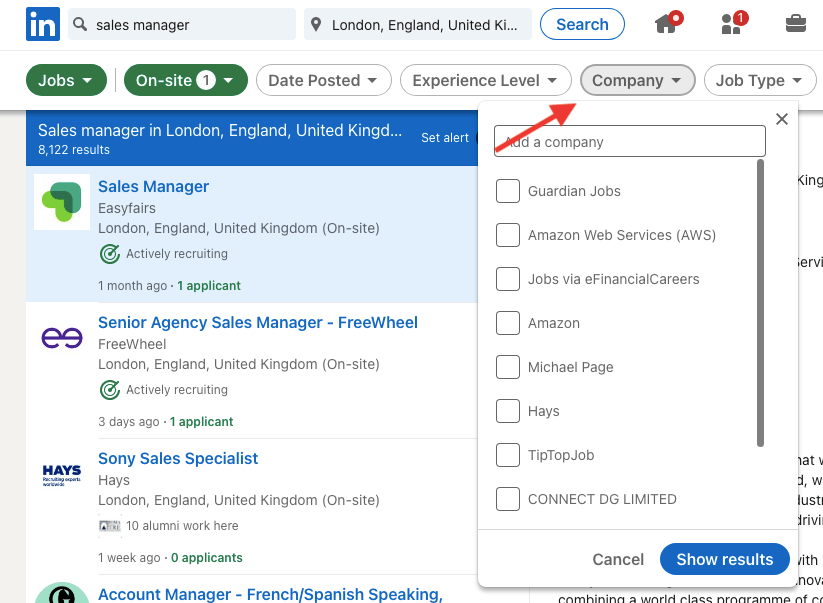
#4 Once you’ve set everything, turn the alert on and receive alerts for multiple companies or a single alert for multiple companies.
10. Target specific job openings
This hack involves searching for job openings and functions, listing companies in a spreadsheet, and contacting decision-makers. It targets current job openings, unlike the long-term strategy of setting alerts and waiting, which offers immediate search results to work with.
This is how you find leads by targeting specific job openings 👇
#1 Put the keyword in the LinkedIn search engine. For example, search for a “Sales Manager”. Set all filters to get as close as possible to your ICP.
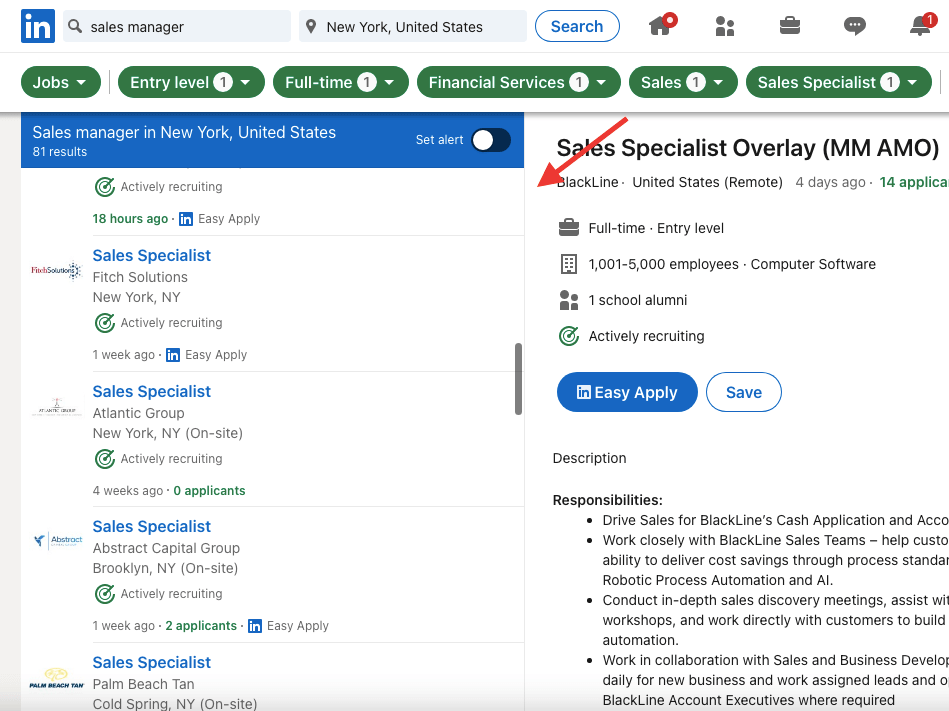
#2 Manually add each company (or handpick your target companies) into a spreadsheet. Then, find decision-makers within these companies and outreach away! ✨
11. Target your competitor’s network
Targeting your competitor’s network on LinkedIn can be an effective prospecting hack, as their connections are likely qualified leads already interested in similar products or services. To put this hack into practice, you have to connect with competitors, as it applies only to your 1st-degree connections.
Option 1 - Go to your competitor’s LinkedIn profile and find their connection list
#1 Go to your competitor’s profile and click on their connection list.
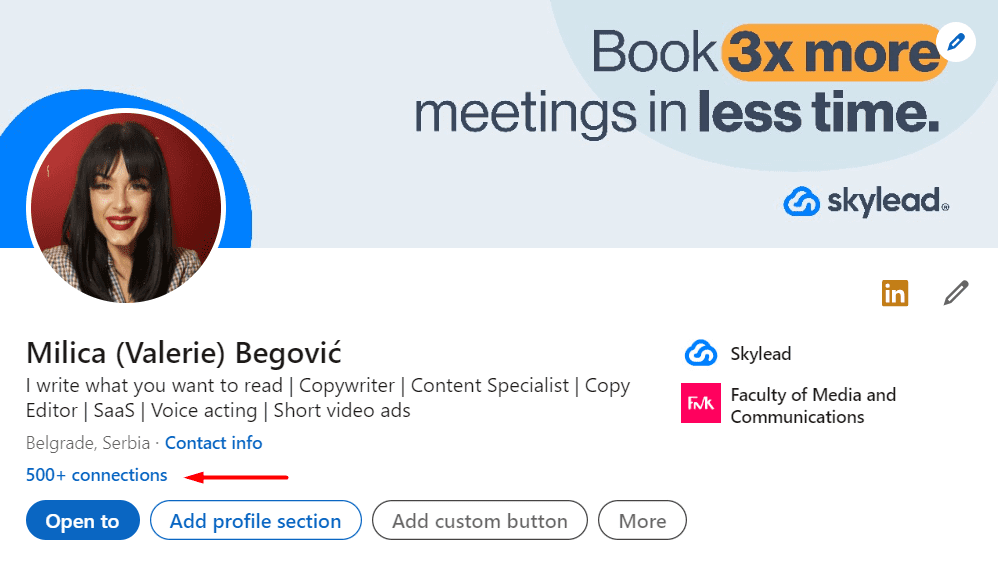
#2 Once you click, you will be able to filter your leads further. You can then handpick them or copy-paste the link of your final search result to a LinkedIn automation tool, such as Skylead.
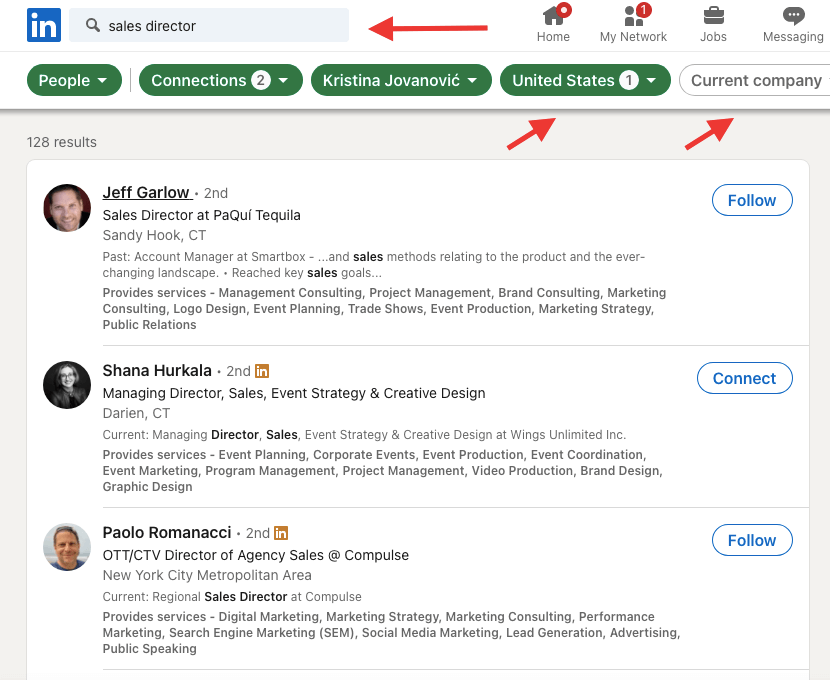
Option 2 - Search for your competitor’s connections through LinkedIn filters
#1 Type a keyword into the search bar or run a blank search. Click “All filters”.

#2 Scroll down to the “Connections Of” filter. You can target one competitor or multiple competitors’ connections. Filter your search results by using other LinkedIn filters.
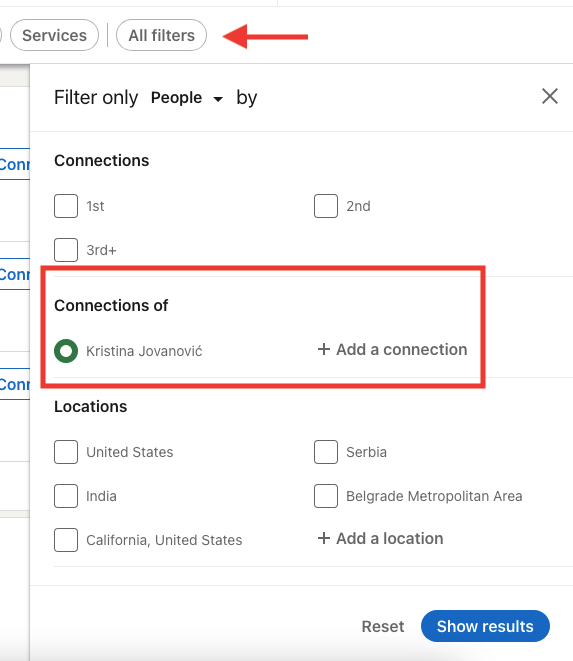
12. Reach out to people who endorsed your competitor or ICP
Keep in mind that people often connect with those similar to themselves in lead generation. Explore the "Skills" section on LinkedIn profiles, both yours and your competitors', to find potential leads through shared connections and endorsements.
#1 Scroll all the way down your potential prospect’s profile.
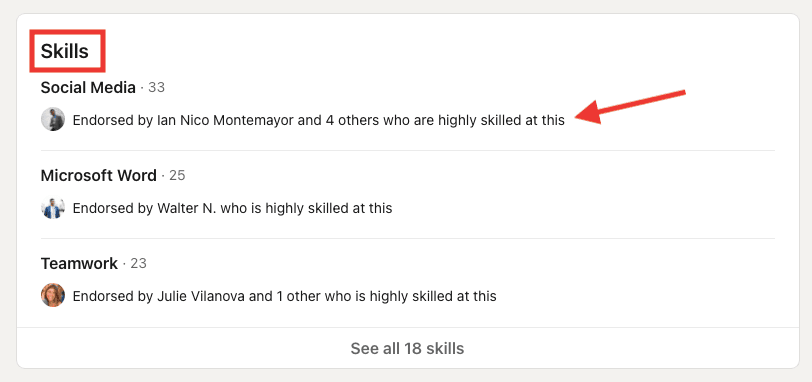
#2 As you may see, there’s a total number of people who endorsed your prospect for a certain skill. LinkedIn automatically shows only those who are categorized as “highly skilled.”
Note: When you have many connections that endorse you for a particular skill, LinkedIn marks you as “highly skilled.” Click on the link as marked above.
This is how it looks 👇
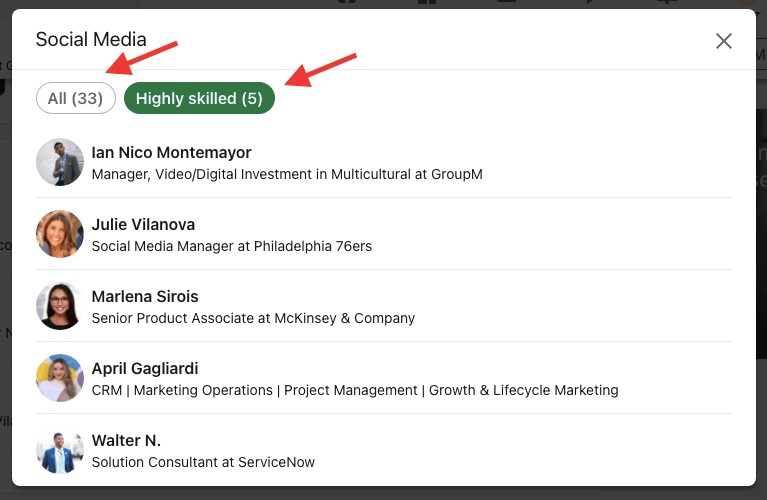
You can target everyone from the list or just the individuals marked as “highly skilled.” They are most likely to be from the same industry or use the services of your prospect.
Note: From our 5-year experience in the market, we found that endorsing someone on LinkedIn doesn’t have the same weight as writing a recommendation. The LinkedIn members you find through the Recommendations section are more likely to be high-quality prospects.
13. Target leads who wrote or received a recommendation
As mentioned above, checking the recommendation section of a prospect's LinkedIn profile is a smart move. It reveals members who have written or received recommendations, along with their names, current titles, and relationship to your prospect. This provides immediate insight into their business connections.
Let’s look at an example 👇
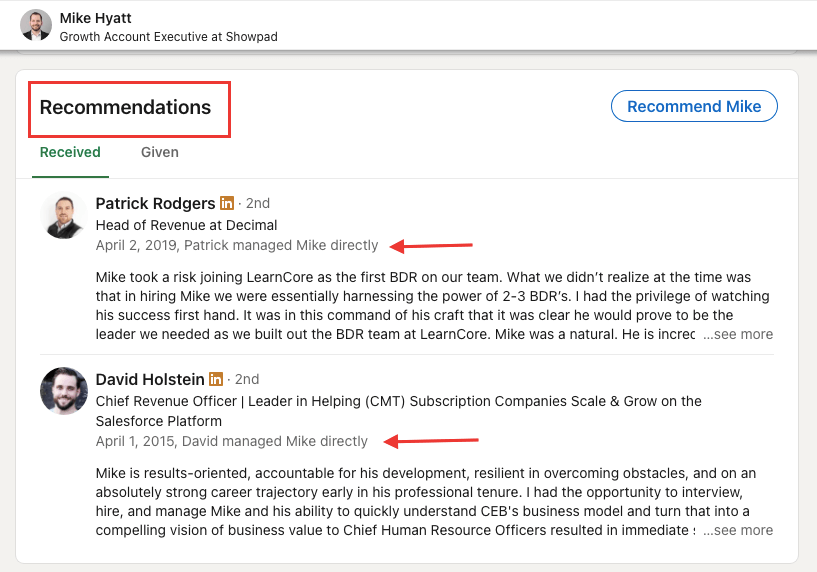
You can check out both your prospect’s recommendations and the ones your prospect wrote for others.

When leaving recommendations, you need to specify the type of business relationships you had with that LinkedIn member, as well as the position you held at the moment.
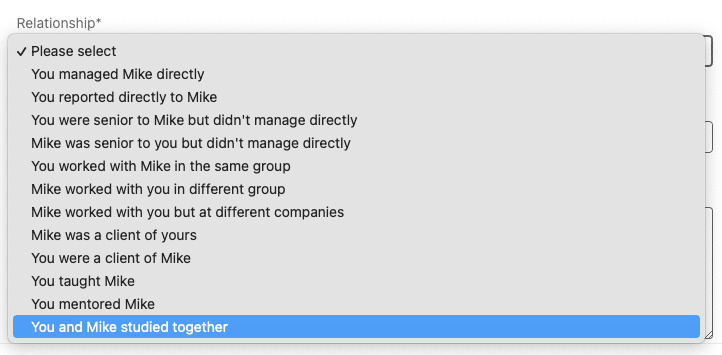
Note: The type of relationship will be displayed together with your recommendation.
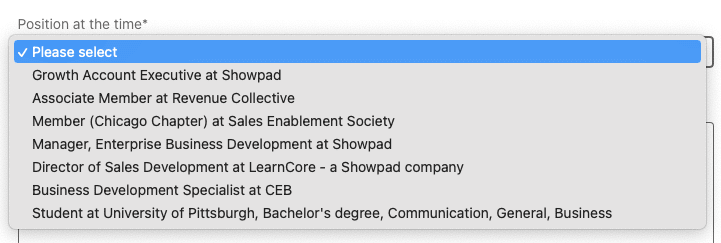
14. Target members who commented or reacted to your ideal prospect's LinkedIn post
For LinkedIn prospecting, only target posts relevant to your business and engaged by members that fit your Buyer Persona. Focus on posts from your industry, similar businesses, or those shared by people targeting or engaging your Buyer persona.
Here are two ways to find a LinkedIn post ideal for prospecting.
Option 1 - Find a LinkedIn member whose posts you want to target
#1 Scroll down through their profile and check out the “Activity” section. Click “See all activity.”
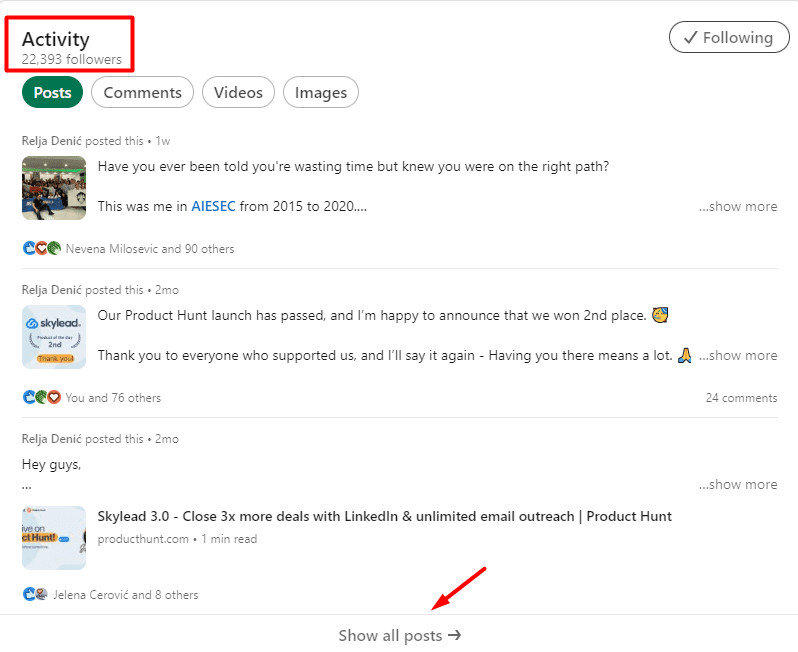
#2 Click “Posts” to see only content posted by that LinkedIn member.

#3 Choose a post that you want to target. If you are doing outreach manually, click here to see who reacted and commented on this particular post.
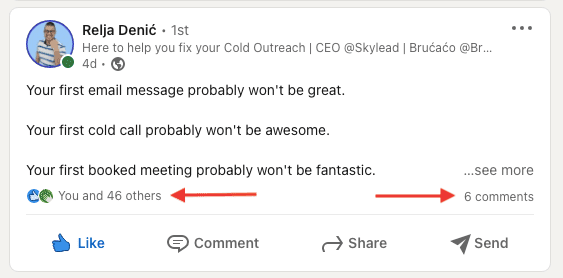
#4 If you’re using a LinkedIn automation tool, this is where you copy a link to a post.
Note: The majority of LinkedIn automation tools can target only members who reacted (not commented) to a certain post.
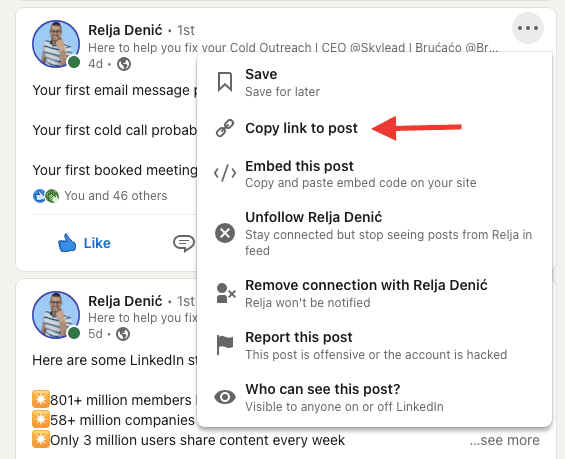
Option 2 - Find a LinkedIn post by using LinkedIn filters
#1 Use LinkedIn's search bar to find posts containing your keyword that interest your ideal prospects.

#2 Filter your posts further if necessary.

#3 Collect prospects either manually or by using a LinkedIn automation tool.
15. Reach out to people who reacted or commented on your post
Using LinkedIn content for prospecting allows you to create tailored posts, articles, or LinkedIn polls to attract qualified prospects. Engage with them by asking questions, starting discussions, or teasing about new releases, and then identify potential leads manually or with a LinkedIn automation tool.
16. Check your company’s LinkedIn page followers
Running out of places to look for prospects? Why not target individuals who follow your LinkedIn company page but don't use your services or products? They might be in related industries, seeking information, exploring options, or staying updated just in case they need you someday. The best way to understand their interest is by reaching out to them.
Option 1 - Check out your company page as an admin
Step #1 You need to be your LinkedIn company page admin to see the list of your followers.
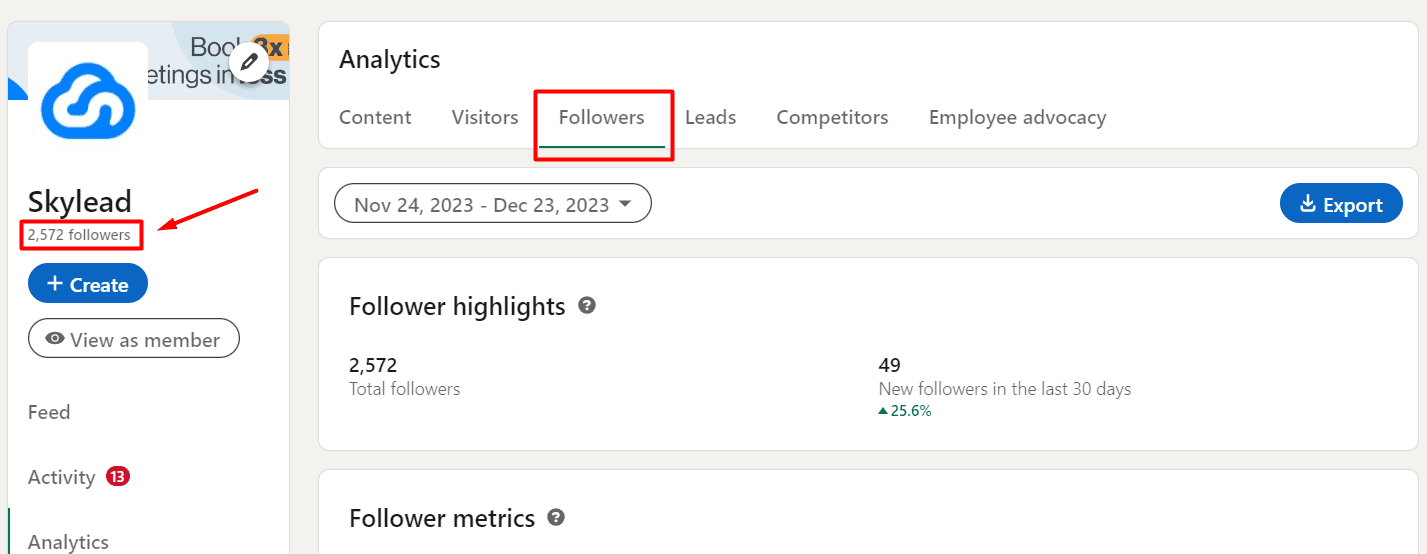
This is how the follower list looks like 👇
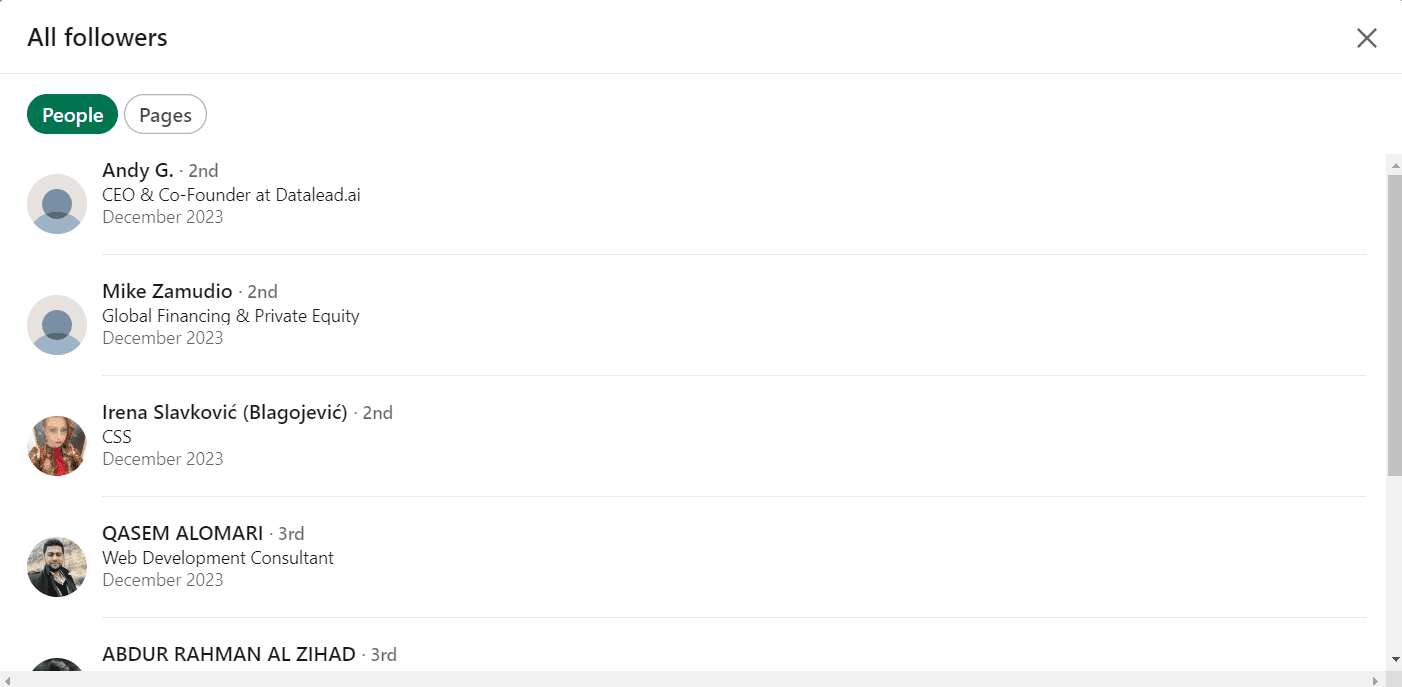
Option 2 - Sales Navigator spotlights filters: Leads that follow your company page
Step #1 Go to Sales Navigator Filters. Click “Lead Filters”.

Step #2 Choose the “Spotlight” filter. Click on “Leads that follow your company on LinkedIn”. You can use other filters to narrow down your search results.
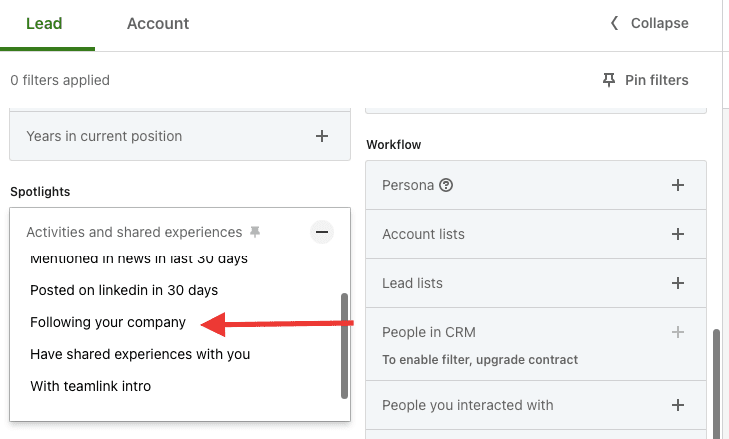
17. Check out the Who’s Viewed Your Profile feature
People view your LinkedIn profile for various reasons. You appeared:
- in their feed
- search results
- recommendations
- company website listings
- through mutual connections.
This indicates potential interest and a good sales rep will take any signal and turn it into a valid reason to reach out. Now go try it out!
This is where you can see who viewed your profile on LinkedIn. 👇
Option 1 - Check your notifications

Option 2 - Check out the Analytics section
The LinkedIn Analytics section is right below the section with your profile picture, name, headline, and other info.
Step #1 Find the “Analytics” section.

Step #2 Check out who viewed your profile.
You’ll find the list of LinkedIn members who viewed your profile. You can use the available filters to narrow down your list.

Interesting Viewers is a category of profile views that LinkedIn's algorithm assumes you'd be most interested in talking to. Aside from that, LinkedIn will categorize certain contacts according to their company, industry, occupation, etc. This can be useful for LinkedIn prospecting.
18. Activate the Bell feature
Did you know you can get notified if your prospect makes an action on their LinkedIn profile? If you activate the Bell feature, you won’t miss an opportunity to talk to your prospects, plus you can learn about their pain points and use that for your outreach messages. How to get the bell to ring? Follow the steps below 👇
Step #1 Go to your prospect’s LinkedIn profile. If you are not connected, click the “Follow” button first, and then turn the bell on. If they are your 1st-degree connection, just click the “Bell” button.
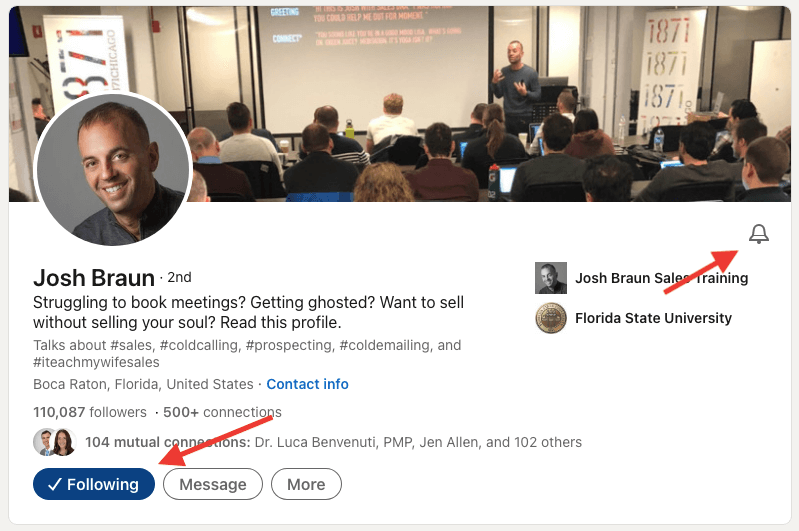
Step #2 You’ll get a notification each time your lead publishes something. It looks like this.

LinkedIn prospecting: Top 3 tools to use
Now, when it comes to LinkedIn prospecting, strategies are good, but what if we told you some tools could help speed up the process? Before we get into the examples, let’s review some basic knowledge about LinkedIn automation tools.
What you need to know is that automation tools come in many shapes and sizes, but their type is what needs to be one of the first things to look at. We have three types of automation tools:
- Browser extensions - Browser-based LinkedIn tools need an extension download to work. To use them, all you need to do is open LinkedIn and activate the extension. The tricky part is that it is less safe to use because it injects a code into LinkedIn, making it noticeable to LinkedIn’s algorithms that search and ban suspicious, non-human behavior.
- Desktop apps - Desktop-based tools require a PC download to work. They act like desktop apps, and they need to work in the background at all times for the automation to happen. Apart from that, all data is stored on your computer. However, you can’t turn your PC off if you want it to work, and it is detectable by LinkedIn, so it’s a safety concern right away.
- Cloud-based - Finally, cloud-based tools use a dedicated IP address that serves as a proxy and shields from all automated activity, so LinkedIn won’t notice the automation happening. Your data is stored in a cloud, which makes it even more safe, and it also runs even when your computer is off.
So, when picking a tool, it’s easy to conclude that cloud-based is the way to go! Now let’s look at the tools 👇
1. Skylead
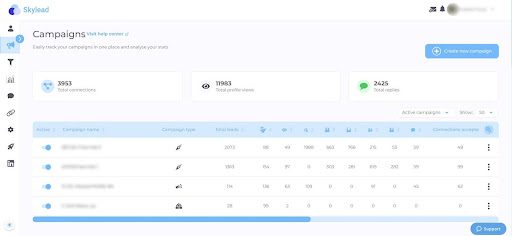
As we’ve mentioned a bit earlier, Skylead is a LinkedIn automation and cold email software, and since prospecting comprises of two parts, finding and nurturing the clients, our tool will help with the outreach and nurturing part.
The LinkedIn automation solution helps you automate LinkedIn action and email. Plus, by using Image & GIF personalization, you can personalize all messages in a follow-up sequence, not just the initial one.
Lastly, our first-to-market Smart sequences help combine LinkedIn with unlimited email automation, thus covering all user behavior actions and reaching prospects one way or the other. Remember - multichannel sequences are the future of outreach!
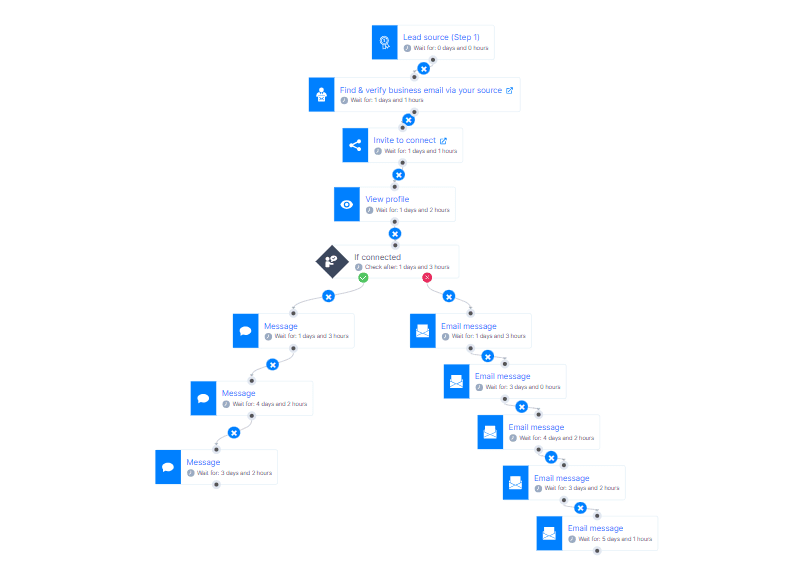
2. LinkedIn Sales Navigator
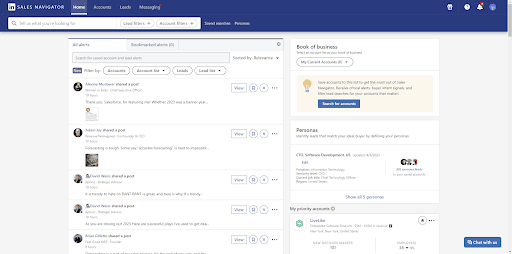
Sales Navigator is LinkedIn’s premium platform created for B2B sales and marketing professionals to prospect and generate leads for their businesses. Every Sales Navigator feature is prospecting-oriented and aims to give you the most relevant information and insights into your desired companies and their decision-makers.
Sales Navigator benefits:
- Sales Navigator advanced filtering options (with 29 Lead Filters and 15 Account Filters) to help you find your Buyer Persona or ICP
- Lead suggestions according to your sales preferences
- Add prospects to custom-made lists
- An advanced notification system (set customizable alerts, and you’ll receive notifications when certain actions are done by prospects) and more.
Also, when you subscribe to one of 3 Sales Navigator plans, you can still enjoy all the benefits of LinkedIn Premium without additional charges.
3. Hubspot
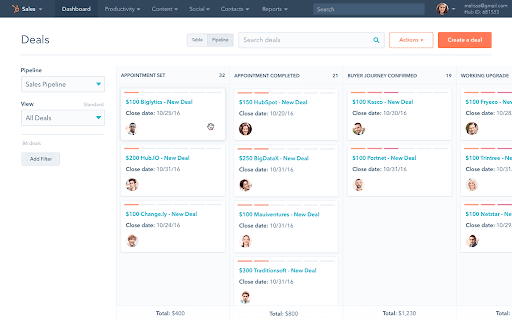
Another tool that you probably heard of used for prospecting and lead management is Hubspot. It’s a free CRM solution that helps sales reps monitor their prospect lists and outreach stage.
This CRM helps you take complete control of your entire sales process, starting with creating your prospect lists. Once you import new prospects, Hubspot offers an enrichment feature that will get you crucial company insights.
Hubspot’s paid version, for $500 per month and a minimum of 5 users, includes the following features:
- Creating email sequences and email campaigns
- ABM tools & tools to automate lead generation
- Workflow integration with other apps
- Target accounts dashboard
- Identifying logged-in website visitors to send personalized emails or live chat replies
- Streamlining new lead assignation to your sales representatives
LinkedIn prospecting: The 4 do’s of sales prospecting
Here are the top 4 LinkedIn prospecting tips and best practices to have in mind when prospecting on LinkedIn.
1. Connect on a human level
Successful salespeople remember that prospects are humans and center their sales process, from prospecting to pitching, around this. Social selling, especially on platforms like LinkedIn, is challenging as is and requires frequent follow-ups.
To connect with prospects on a human level, it's important to show genuine care, share personal business struggles or advice, and respect their decision-making time. This approach leads to more positive returns and respects the human aspect of sales. LinkedIn prospecting gives you an insight on what your prospect is all about so you can connect on a deeper level, even online.
2. Provide value
Sales reps should focus on providing value in social selling, both through content and interactions with prospects, regardless of their response to sales pitches. Sharing industry knowledge on LinkedIn positions you as an expert, making prospects more likely to choose you over others.
Also, offering value through direct messages, like recommending resources, sharing ebooks, or giving advice about something they actually need, builds appreciation and trust, no matter their purchase decisions.
3. Personalize
Personalization is crucial in prospecting, and it goes beyond just using the prospect's name. It involves in-depth research to understand and segment prospects. LinkedIn automation tools can automate this process using variables for personalization and CSV files for scaling.
Image & GIF personalization is another effective technique, using customized images with the recipient’s data to capture attention. Tools like Skylead offer image personalization as a feature, allowing you to customize images for each recipient to enhance LinkedIn inbox visibility.
4. Be patient
From what we’ve seen in sales, it’s safe to say with absolute certainty that you shouldn’t be pushy or aggressive with prospects, despite the pressure of monthly or quarterly quotas. Sales reps who focus on nurturing prospects and understanding their stage in the buyer's journey tend to meet their sales quotas more.
Prospects actually value the space to make decisions and appreciate sales approaches that aren't solely focused on closing a sale at any cost, so keep that in mind when reaching out.
LinkedIn prospecting: The don’ts of sales prospecting
Here’s what you should avoid at all costs when prospecting on LinkedIn. 👇
1. Overlooking Profiles Before Reaching Out
Not taking the time to research and go through your prospect’s profile thoroughly before reaching out can lead to irrelevant or inappropriate offers. You need to understand their interests, experiences and needs to help tailor just the right message.
2. Not Following Up
Always keep in mind that messages can be missed or forgotten. Not following up can be a huge mistake and lead to potential client loss. Sometimes, prospects need a little push before they do what you want them to. When writing a follow-up email after no response, make sure not to be too aggressive or pushy.
3. Neglecting LinkedIn Etiquette
Like in the real world, LinkedIn also has a set of rules you need to follow when communicating with people online. Neglecting LinkedIn etiquette could include endorsing people you don't know for skills, joining groups and immediately spamming them with your offers, or not respecting people's time and interests.
4. Ignoring Analytics and Feedback
Lastly, not tracking the performance of your outreach efforts (like response and open rates) could lead to bad outreach results. If you’re not adapting constantly based on real-time metrics and optimizing, you won’t reach any sales goals. So, remember to always look at the numbers and optimize accordingly.
Frequently asked questions about LinkedIn prospecting
How do I measure the success of my LinkedIn prospecting efforts?
Measure success by tracking metrics like connection acceptance, response rates, meetings arranged, and conversion rates. Use LinkedIn Sales Navigator, Skylead or CRM tools for analytics. Consistently analyzing these metrics will help you understand the effectiveness of your strategies and make necessary adjustments to improve your prospecting efforts.
How can I ensure my LinkedIn outreach messages stand out from the competition?
Personalize your messages by referencing specific details from prospects' profiles. Create engaging, value-centric messages that invite a response. Tailoring your outreach to each prospect's interests and needs enhances the likelihood of initiating meaningful conversations, fostering professional relationships, and ultimately achieving successful connections.
What are the common pitfalls to avoid in LinkedIn prospecting, and how can I navigate them?
Avoid common pitfalls by steering clear of mass, impersonal messages and neglecting profile optimization. Focus on crafting tailored, value-driven outreach messages and maintaining a professional, up-to-date LinkedIn profile. Personalized communication combined with a polished online presence is key to sidestepping frequent errors and succeeding in your prospecting endeavors.
How to use LinkedIn Sales Navigator for prospecting?
Use Sales Navigator and its multiple features, such as advanced search and filtering, lead suggestions, and advanced notifications to search for the right audience - your ICP and Buyer Persona, then implement an outreach strategy, preferably using multiple channels.
How do you use LinkedIn for sales prospecting?
Optimize your LinkedIn profile, use LinkedIn or LinkedIn Sales Navigator to target specific leads, actively engage in relevant groups, consistently share insightful content, and effectively use InMail for personalized outreach.
How do I use LinkedIn for prospecting?
First, you need to define your Ideal Customer Profile. Then, identify companies matching it. Lastly, find your Buyer Persona within those companies. Use LinkedIn and Sales Navigator search filters to find qualified prospects. In this blog, we listed 19 additional strategies to find prospects on LinkedIn.
Does LinkedIn work for prospecting?
Yes. LinkedIn is a gold mine for finding qualified prospects for the majority of businesses. With the help of advanced search on LinkedIn and Sales Navigator, you can study prospect information to build qualified lead lists and proceed to implement your sales strategy with better results.
Ready to use LinkedIn prospecting for outreach?
If your goal is to grow your business and your business is outreach, LinkedIn prospecting should be an integral part of your outreach strategy. Although it is complex, LinkedIn prospecting shouldn’t be such a hassle, thanks to advanced tools that can relieve some of the workload.
That’s right, we’re talking about LinkedIn automation tools. Let’s look at the benefits one more time:
- Save time on countless manual tasks
- Use multichannel outreach and double the success rate of your outreach
- Automate parts of the sales process (prospecting, lead generation, lead nurturing)
- Monitor and optimize outreach campaigns with advanced metrics
But how do you get to enjoy all these benefits?
You can try Skylead, of course! 🤩 Simply register for a free trial today and watch how an all-in-one tool can turn something as complex as prospecting into an easily manageable task that produces results.
